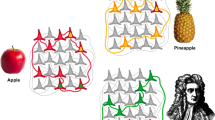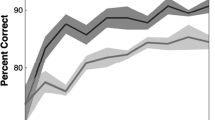Abstract
The ability to associate images is the basis for learning relationships involving vision, hearing, tactile sensation, and kinetic motion. A new architecture is described that has only local, recurrent connections, but can directly form global image associations. This architecture has many similarities to the structure of the cerebral cortex, including the division into Brodmann areas, the distinct internal and external lamina, and the pattern of neuron interconnection. The images are represented as neurotransmitter fields, which differ from neural fields in the underlying principle that the state variables are not the neuron action potentials, but the chemical concentration of neurotransmitters in the extracellular space. The neurotransmitter cloud hypothesis, which asserts that functions of space, time and frequency, are encoded by the density of identifiable molecules, allows the abstract mathematical power of cellular processing to be extended by incorporating a new chemical model of computation. This makes it possible for a small number of neurons, even a single neuron, to establish an association between arbitrary images. A single layer of neurons, in effect, performs the computation of a two-layer neural network.
Analogous to the bits in an SR flip-flop, two arbitrary images can hold each other in place in an association processor and thereby form a short-term image memory. Just as the reciprocal voltage levels in a flip-flop can produce a dynamical system with two stable states, reciprocal-image pairs can generate stable attractors thereby allowing the images to serve as symbols. Spherically symmetric wavelets, identical to those found in the receptive fields of the retina, enable efficient image computations. Noise reduction in the continuous wavelet transform representations is possible using an orthogonal projection based on the reproducing kernel. Experimental results demonstrating stable reciprocalimage attractors are presented.
Preview
Unable to display preview. Download preview PDF.
Similar content being viewed by others
References
Brodmann, K.: Vergleichende Lokalisationslehre der Grosshirnrinde in ihren Prinzipien dargestellt auf Grund des Zellenbaues. Barth, Leipzig (1909)
Kandel, E.R., Schwartz, J.H., Jessell, T.M.: Principles of Neural Science, 4th edn. McGraw-Hill, New York (2000)
Garoutte, B.: Survey of Functional Neuroanatomy, 3rd edn. Mill Valley Medical, California (1994)
Spivak, M.: A Comprehensive Introduction to Differential Geometry, 3rd edn. Publish or Perish, Wilmington (1979)
Schutz, B.: Geometric Methods of Mathematical Physics. Cambridge University Press, Cambridge (1980)
Knudsen, E.I., du Lac, S., Esterly, S.D.: Computational Maps in the Brain. Ann. Rev. of Neuroscience 10, 41–65 (1987)
Greer, D.S.: A Unified System of Computational Manifolds. Tech. Rep. TR-CIS-0602-03, Dept. of Comp. and Info. Sci., IUPUI, Indianapolis (2003)
Monad, J.: Chance and Necessity: An Essay on the Natural Philosophy of Modern Biology (Trans. A. Wainhouse). Knopf, New York (1971)
Mallat, S.: A Wavelet Tour of Signal Processing, 2nd edn. Academic Press, San Diego (1999)
Wang, Y.: The Cognitive Processes of Abstraction and Formal Inferences. In: Proc. 4th IEEE International Conf. on Cognitive Informatics, Irvine, California (2005)
Wang, Y.: The Theoretical Framework of Cognitive Informatics. International J. of Cognitive Informatics and Natural Intelligence 1(1), 1–27 (2007)
Yao, Y.Y.: Concept Formation and Learning: a Cognitive Informatics Perspective. In: Proc. 3rd IEEE International Conf. on Cognitive Informatics, Victoria, Canada (2004)
Prince, V., Lafourcade, M.: Mixing Semantic Networks and Conceptual Vectors Application to Hyperonymy. IEEE Trans. Systems, Man and Cybernetics, C 36, 152–160 (2006)
Willshaw, D.J., Buneman, O.P., Longuet-Higgins, H.C.: Non-holographic Associative Memory. Nature 222, 960–962 (1969)
Kosko, B.: Bidirectional Associative Memories. IEEE Trans. Systems, Man and Cybernetics 18, 49–60 (1988)
Xu, Z., Leung, Y., He, X.: Asymmetrical Bidirectional Associative Memories. IEEE Trans. Systems, Man, and Cybernetics 24, 1558–1564 (1994)
Chua, L.O., Yang, L.: Cellular Neural Networks: Theory. IEEE Trans. Circuits and Systems 35(10), 1257–1272 (1988)
Zhang, Q., Benveniste, A.: Wavelet Networks. IEEE Trans. Neural Networks 3(6), 889–898 (1992)
Thuillard, M.: A Review of Wavelet Networks, Wavenets, Fuzzy Wavenets and their Applications. In: Advances in Computational Intelligence and Learning: Methods and Applications. Kluwer, Deventer (2002)
Iyengar, S.S., Cho, E.C., Phoha, V.V.: Foundations of Wavelet Networks and Applications. CRC, Boca Raton (2002)
Beurle, R.L.: Properties of a Mass of Cells Capable of Regenerating Pulses. Philosophical Trans. of the Royal Society. Series B 240, 55–94 (1956)
Griffith, J.S.: A Field Theory of Neural Nets: I: Derivation of Field Equations. Bulletin of Mathematical Biophysics 25, 111–120 (1963)
Griffith, J.S.: A Field Theory of Neural Nets: II. Properties of the Field Equations. Bulletin of Mathematical Biophysics 27, 187–195 (1965)
Amari, S.: Dynamics of Pattern Formation in the Lateral-Inhibition Type Neural Fields. Biological Cybernetics 27, 77–87 (1977)
Ermentrout, B.: Neural Networks as Spatio-temporal Pattern-Forming Systems. Reports on Progress in Physics 61, 353–430 (1998)
Vogels, T.P., Rajan, K., Abbott, L.F.: Neural Network Dynamics. Annual Rev. Neuroscience 28, 357–376 (2005)
Sarnat, H.B., Netsky, M.G.: Evolution of the Nervous System, 2nd edn. Oxford (1981)
Widrow, B., Hoff, M.E.: Adaptive Switching Circuits. WESCON Convention Record, pp. 96–104. IRE, New York (1960)
Royden, H.L.: Real Analysis, 3rd edn. Prentice-Hall, Englewood Cliffs (1988)
Greer, D.S.: Neurotransmitter Fields. In: Proc. of International Conf. on Artificial Neural Networks, Porto, Portugal (2007)
Bishop, C.M.: Neural Networks for Pattern Recognition. Oxford University Press, Oxford (1995)
Thompson, J.M.T., Stewart, H.B.: Nonlinear Dynamics and Chaos. Wiley, Hoboken (2002)
Nevatia, R.: Machine Perception. Prentice-Hall, Englewood Cliffs (1982)
Churchland, P., Sejnowski, T.J.: The Computational Brain. MIT Press, Cambridge (1994)
Daubechies, I.: Ten Lectures on Wavelets. Society for Industrial and Applied Mathematics, Philadelphia (1992)
Addison, P.S.: The Illustrated Wavelet Transform Handbook. Institute of Physics Publishing, Bristol (2002)
Aronszajn, N.: Theory of Reproducing Kernels. Trans. of the American Mathematical Society 68(3), 337–404 (1950)
Saitoh, S.: Integral Transforms, Reproducing Kernels and their Applications. Addison Wesley Longman, Essex (1997)
Thompson, K.: Alpha Blending. In: Glassner, A. (ed.) Graphics Gems, pp. 210–211. Academic Press, Cambridge (1990)
von Economo, G.N., Koskinas, G.N.: The Cytoarchitectonics of the Adult Human Cortex (trans. H. L. Seldon). Springer, Heidelberg (1925)
Greer, D.S.: The Computational Manifold Approach to Consciousness and Symbolic Processing in the Cerebral Cortex. In: Proc. 7th IEEE International Conference on Cognitive Informatics (2008)
Behrens, T.E.J., Johansen-Berg, W.H.M.W., Smith, S.M., Wheeler-Kingshott, C.A.M., Boulby, P.A., et al.: Non-invasive Mapping of Connections between Human Thalamus and Cortex Using Diffusion Imaging. Nature Neuroscience 6(7), 750–757 (2003)
Robinson, J.C.: Infinite-Dimensional Dynamical Systems: An Introduction to Dissipative Parabolic PDEs and the Theory of Global Attractors. Cambridge University Press, Cambridge (2001)
Greer, D.S.: Sapphire 0.4 Implementation Notes. Tech. Rep. TR-CIS-0714-08, Dept. of Comp. and Info. Sci., IUPUI, Indianapolis (2008)
Computational Results, http://www.gmanif.com/results.html
Author information
Authors and Affiliations
Editor information
Editors and Affiliations
Rights and permissions
Copyright information
© 2009 Springer-Verlag Berlin Heidelberg
About this chapter
Cite this chapter
Greer, D.S. (2009). Images as Symbols: An Associative Neurotransmitter-Field Model of the Brodmann Areas. In: Gavrilova, M.L., Tan, C.J.K., Wang, Y., Chan, K.C.C. (eds) Transactions on Computational Science V. Lecture Notes in Computer Science, vol 5540. Springer, Berlin, Heidelberg. https://doi.org/10.1007/978-3-642-02097-1_3
Download citation
DOI: https://doi.org/10.1007/978-3-642-02097-1_3
Publisher Name: Springer, Berlin, Heidelberg
Print ISBN: 978-3-642-02096-4
Online ISBN: 978-3-642-02097-1
eBook Packages: Computer ScienceComputer Science (R0)




